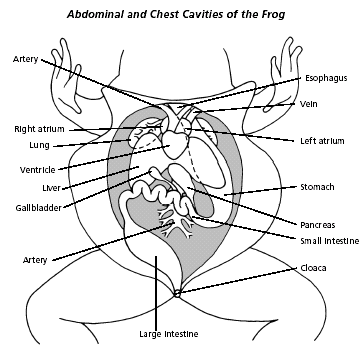Wow I actually dissected a frog and I can't believe it! During the past two days we dissected a frog and learned how the frog's organs functions and where they are, what are the organ systems, and how the frog is connected to us. So I got to admit I was pretty scared in the beginning because of the frogs organs, but then when I start to dissect it, I had a tremendous amount of fun. If I were to be able to do it again I would do it. So first lets start what the organs are. The liver: The largest structure of the the body cavity. This brown colored organ is composed of three parts, or lobes. The right lobe, the left anterior lobe, and the left posterior lobe. The liver is not primarily an organ of digestion, it does secrete a digestive juice called bile. Bile is needed for the proper digestion of fats.Now the Heart:at the top of the liver, the heart is a triangular structure. The left and right atrium can be found at the top of the heart. A single ventricle located at the bottom of the heart. The large vessel extending out from the heart is the conus arteriosis. Lungs: Locate the lungs by looking underneath and behind the heart and liver. They are two spongy organs. The Gall bladder: Lift the lobes of the liver, there will be a small green sac under the liver. The gall bladder, which stores bile(hint: it kind of looks like a booger). Stomach: Curving from underneath the liver is the stomach. The stomach is the first major site of chemical digestion. Frogs swallow their meals whole. Follow the stomach to where it turns into the small intestine. The pyloric sphincter valve regulates the exit of digested food from the stomach to the small intestine.The Small Intestine: Leading from the stomach. The first straight portion of the small intestine is called the duodenum, the curled portion is the ileum. The ileum is held together by a membrane called the mesentery. Note the blood vessels running through the mesentery, they will carry absorbed nutrients away from the intestine. Absorption of digested nutrients occurs in the small intestine. Then comes the Large Intestine:As you follow the small intestine down, it will widen into the large intestine. The large intestine is also known as the cloaca in the frog. The cloaca is the last stop before wastes, sperm, or urine exit the frog's body. (The word "cloaca" means sewer). Then the Spleen:Return to the folds of the mesentery, this dark red spherical object serves as a holding area for blood. Finally the Esophagus: Return to the stomach and follow it upward, where it gets smaller is the beginning of the esophagus. The esophagus is the tube that leads from the frogs mouth to the stomach. Open the frogs mouth and find the esophagus, poke your probe into it and see where it leads.
Now lets talk about it's systems of the organs. Well you may ask what is the Digestive System? The Digestive System is a complex series of organs and glands that processes food. In order to use the food we eat, our body has to break the food down into smaller molecules that it can process; it also has to excrete waste. The Liver, Gall bladder, Pancreas, Stomach, and Small Intestine are all part of the Digestive System.The circulatory system is an organ system that passes nutrients (such as amino acids, electrolytes and lymph), gases, hormones, blood cells, etc. to and from cells in the body to help fight diseases, stabilize body temperature and pH, and to maintain homeostasis.The Respiratory System is made up of the organs in your body that help you to breathe.The goal of breathing is to deliver oxygen to the body and to take away carbon dioxide. The Lungs and Skin are both parts of the Respiratory System.The Nervous System is an organ system containing a network of specialized cells called neurons that coordinate the actions of an animal and transmit signals between different parts of its body. In most animals the nervous system consists of two parts, central and peripheral. Now it is time to talk about how the Frog is connected to us the humans.
The Frog is connected to us in many scientific ways! Frogs and humans similarities are that we both have a stomach, small intestine, large intestine, heart, lungs, pancreas, and gall bladder frogs and human were that we both have a stomach, small intestine, large intestine, heart, lungs, pancreas, and gallbladder. We both have a reproductive system to build our population.We may not be connected on the outside because size and shape but on the inside we are and this is how. We both have a heart that pumps blood and we both have lungs that give our body oxygen. Frog's reproductive organs are on the inside as where humans' are on the outside. Frogs have white hearts and humans have red hearts. You can see a frogs Esophagus through its mouth, but you can't see it from humans.
In conclusion, I think I had a very fun time and I wish I can do this again. It was a good experience and I learned a lot about the frogs which helped me learn something about myself. I hope we can do this again someday!
Links: http://www.biologycorner.com/worksheets/frog-dissection.html




No comments:
Post a Comment